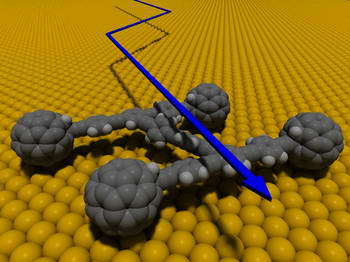A car about four nanometers long, with wheels each made of 60 carbon atoms, was able to drive on a gold surface. The researchers claim that in the future it will be possible to develop tiny facilities that will be used for both research and applied needs
Yoram Ored, Galileo

The experiments conducted in the field of nanotechnology are sometimes seen as purely intellectual exercises by scientists, more than as activities motivated by the need to reach the research and development of this innovative field. Over the past few years, various tiny objects have been developed, including a guitar and a locomotive. Recently, scientists at Rice University have developed a tiny car, made entirely of a single molecule. The car contains a chassis (which we usually call "chassis" in our places), axles and four wheels.
Why develop tiny cars, or other tiny machines? One of the developers of the molecular car, James M. Tour, claims that the construction of such tiny facilities gives us a critical look at our research on bottom-up manufacturing, a phrase that means building objects by joining atoms together, atom by atom Another atom, until the desired object is created. Such construction is one of the hallmarks of nanotechnology.
Meanwhile, nanotechnology deals with the construction of tiny objects, such as the tiny car mentioned above. Another goal, according to Tor, is to produce tiny objects on the order of nanometer size (nanometer - one billionth of a meter) that will be able to control their movement. The development of tiny vehicles such as the tiny car is a suitable means of examining the possibilities of understanding the laws concerning the movement of objects of such magnitudes.
The wheels of the tiny car are actually balls. These are buckyballs, each made of sixty carbon atoms. The length of the entire car reaches about four nanometers. For comparison, the thickness of a human hair reaches approximately 80 thousand nanometers. In other words, 20 of these tiny cars could be lined up the width of one human hair.
The researchers who developed the nanocar were able to drive it using scanning tunneling microscopy (STM). The scanning tunneling microscope is equipped with a needle whose tip is a single atom thick. When the tip of the needle gets very close to another atom, a great electrical repulsion is created between them, and the other atom - which is free to move - moves. The nanocar is able to move by turning its wheels, and not just by sliding on the surface it is on. To move the car by turning the wheels, the researchers placed it on a gold surface and heated it to a temperature of 200 degrees Celsius.
At room temperature, the electrical forces acting between the atoms of the gold surface and the car's wheels cause the car to stick tightly to the surface. When the surface is heated to a temperature of 200 degrees Celsius, the electrical forces between the surface and the car's wheels (which, as mentioned, are spheres made of carbon atoms) loosen, and the rolling of the wheels on the surface becomes possible.
What will be the next step in the development of nanometer-sized vehicles - nanocar racing?

2 תגובות
I would like to live longer, if only to see this wonder with my own eyes :))